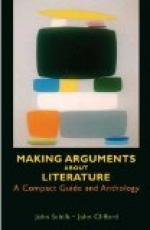We cannot absolutely know that all these exact adaptations are, the result of preconcert. But when we see a lot of framed timbers, different portions of which we know have been gotten cut at different times and places and by different workmen,—Stephen, Franklin, Roger, and James, for instance,—and we see these timbers joined together, and see they exactly make the frame of a house or a mill, all the tenons and mortises exactly fitting, and all the lengths and proportions of the different pieces exactly adapted to their respective places, and not a piece too many or too few, not omitting even scaffolding,—or, if a single piece be lacking, we see the place in the frame exactly fitted and prepared yet to bring such piece in,—in such a case we find it impossible not to believe that Stephen and Franklin and Roger and James all understood one another from the beginning, and all worked upon a common plan or draft drawn up before the first blow was struck.
On the other hand, there is the danger of being florid or of playing the clown if you tell too many stories. Whether your style will seem florid or not depends a good deal on the part of the country you are writing for. There is no doubt that the taste of the South and of a good deal of the West is for a style more varied and highly colored than suits the soberer taste of the East. But whatever part of the country you are writing for, just so soon as your style seems to those special readers overloaded with ornament it will seem insincere. In the same way, if you stop too often to tell a story or to make your readers laugh, you will produce the impression of trifling with your subject. In both these respects be careful not to draw the attention of your readers away from the subject to your style.
The ultimate and least analyzable appeal of style is through that thrill of the voice which in written style appears as rhythm and harmony. Certain men are gifted with the capacity of so modulating their voices and throwing virtue into their tones that whoever hears them feels an indefinable thrill. So in writing: where sounds follow sounds in harmonious sequence, and the beat of the accent approaches regularity without falling into it, language takes on the expressiveness of music. It is well known that music expresses a range of feeling that lies beyond the powers of words: who can explain, for example, the thrill roused in him by a good brass band, or the indefinable melancholy and gloom created by the minor harmonies of one of the great funeral marches, or, in another direction, the impulse that sets him to whistling or singing on a bright morning in summer? There are many such kinds of feeling, real and potent parts of our consciousness; and if we can bring them to expression at all, we must do so through the rhythm and other sensuous qualities of the style which are pure sensation.




